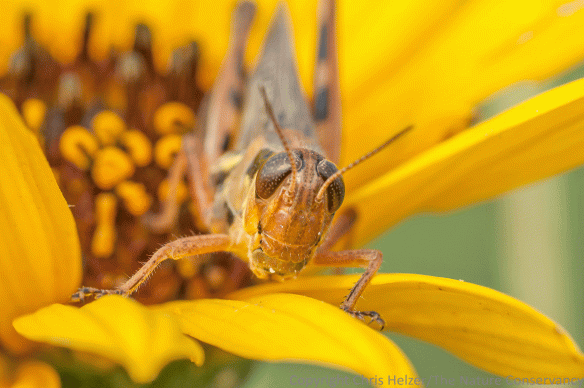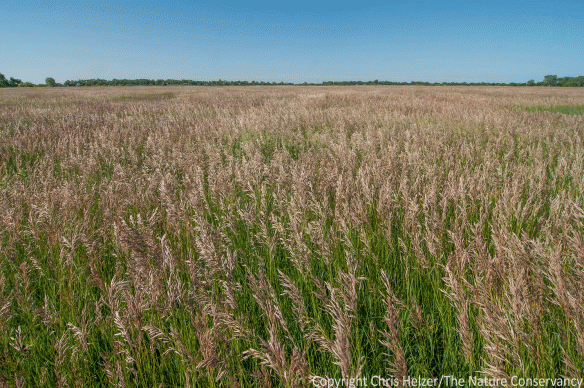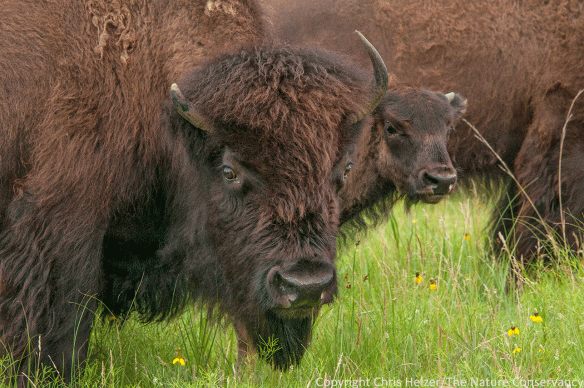What’s the minimum effective size of a prairie?
For example, can a prairie be the size of a kitchen table? Let’s say someone converted a landscape full of prairie to an immense gravel parking lot, leaving only a round kitchen table-sized parcel of vegetation in the middle. Is that tiny isolated parcel a prairie?
The question might seem silly, but the question became a useful little thought experiment for me.
That little parcel certainly wouldn’t be big enough to meet the needs of most prairie animals. Birds, small mammals, snakes, and even smaller creatures like grasshoppers and bees would be unable to find enough food to survive within that small area. The loss of those animals would affect many of the ecological services and functions that make prairies work. Those services include pollination, nutrient cycling, herbivory and more.

Even small creatures like grasshoppers would have a hard time surviving in a patch of plants the size of a kitchen table.
Some tiny herbivorous invertebrates might be able to survive in that little parcel of vegetation, but probably not enough of them to support most predators that feed on them. The lack of predation would allow those invertebrate populations to grow much larger than they otherwise would, leading to significant damage, or even mortality, to the plants they feed on. Once their food is gone, the invertebrates would starve and die as well.
Plants that manage to survive invertebrate attacks and an absence of pollinators in our little parcel would still face major challenges. In the long-term, they would probably suffer from a huge genetic bottleneck because they don’t have other individuals of their species to cross breed with. In the meantime, it would take a lot of intensive and thoughtful management to keep them alive.

Smooth brome and other invaders can quickly dominate small prairie patches without constant vigilance and suppression.
Invasive species management would be a huge problem because it wouldn’t take long for an aggressive invader to quickly dominate that small area. Quick action would be needed to remove invasive plants as they arrive. Fire or mowing would also be needed to prevent a smothering thatch from accumulating as plants grow and die back each year. Unfortunately, every fire would kill most invertebrates aboveground at the time and destroy their food sources. We could try to burn only a portion of the parcel and save some of the insects, but with such small populations, we’d still probably lose most species eventually. Mowing and raking might be an alternative, but we’d still end up removing either the invertebrates or their food sources.
Ok, so we’d just have to live without most prairie animals, but we’d still have plants. Or at least a few of them. Some of those plants would be more competitive than others, especially in an animal-less environment, so it would take a lot of effort to keep them from pushing the less competitive plants out. And, of course, we’re assuming the mysterious belowground processes that allow plants to survive would still function in our tiny parcel – microbial relationships that allow plants to access and process water and nutrients, for example. If those are sufficiently intact, we’d have some plants.
Would that be a prairie?
I’m pretty sure no one would argue that a kitchen table-sized area containing few plants is a prairie. Even in the first moments after the parking lot was created, I would argue the remaining patch of vegetation had ceased to be a prairie, even though it still contained a reasonable diversity of plants and animals. It wasn’t really a prairie anymore, just a doomed fragment of its former self.
If we can agree that a kitchen tabled-size patch of land is too small, how big would we have to make that patch before we’d be willing to call it a prairie? What species and/or ecological processes should we use as criteria?
Can we agree a prairie needs to be big enough to support a healthy pollinator community? Does it need to be able to sustain viable populations of small mammals, snakes, leafhoppers, spiders, and other little creatures? Is it a prairie if it doesn’t have a full complement of grassland bird species? Does that requisite bird community include larger birds such prairie chickens or other grouse species? What about at least moderately-sized predators such as badgers and coyotes (or even bigger ones) or large ruminants like bison or elk? Which of those components are we willing to live without, and more importantly, which can a prairie live without and still sustain itself as an ecological system? A prairie without badgers, coyotes or bison is functionally different than one with those animals, but is it a non-prairie or just a different kind of prairie?

Bison herds need very large prairies, but we don’t know as much about the amount of land needed to sustain populations of bees, leafhoppers, jumping mice, or even genetically viable plant populations.
Even if we reach consensus on the key components of a prairie, we’re still hamstrung by our lack of information about how big a prairie needs to be to support each of them. We have decent data on the prairie size requirements for many grassland bird species, but beyond birds, we’re mostly just guessing. If we want the full complement of species, including bison and other large ruminants, we’re going to need thousands of acres, but how many thousands?
More importantly, what does this mean for the many remaining patches of prairie vegetation too small to support whatever we decide are the key components of a prairie? It certainly doesn’t make them worthless, but it might be important to make sure we’re viewing them realistically. What are the likely ramifications of the missing components? The absence of prairie chickens or upland sandpipers might be disappointing, but might not have the ripple effect that the absence of pollinators or coyotes might have. Can we identify and compensate for the absence of key prairie components by managing differently or more intensively? If not, how do we adjust our vision of the future for that prairie parcel, and how does that adjusted vision affect how much management effort we invest? (You can read more about the challenges of managing small prairies here.)
For many of today’s small prairie patches, the only chance of preserving their species and ecological functions is to make those small patches larger and/or more connected to others. Restoring adjacent land back to high-diversity prairie vegetation allows formerly landlocked populations to expand and interact with others, and creates enough habitat for larger animals to survive. Identifying potential restoration opportunities might be the highest priority conservation strategy for those of us working with small prairies.

Reasonable plant diversity and the presence of larval host plants like this prairie violet have so far allowed our family prairie to support a population of regal fritillary butterflies, but the small size and isolated nature of our prairie means if the butterflies have a bad year, they could easily disappear and never return.
Our family prairie is a little over 100 acres in size, is managed with large ruminants (cattle), and has regal fritillary butterflies, coyotes, badgers, upland sandpipers, and even an occasional prairie chicken. However, I’m certainly not comfortable that our 100 acre island within a sea of cropland will to sustain a prairie ecosystem indefinitely. This thought experiment has forced me to think more seriously about prospects for increasing the size of our prairie and building connectivity to other grasslands. I hope it’s useful to others as well.

I think you raise a very important point about using resources to do reconstructions to link up existing remnants. Often the focus of the conservation community seems to be on protecting and managing “high quality” remnants and viewing reconstructions and lower “quality” but larger remnants as lower priorities. The underlying issue of course comes down to limited resources and opportunities, we have to deal with what’s available, but your post is a discussion all prairie conservation efforts need to grapple with. Thanks for bringing up the subject!
All excellent thoughts and comments Chris. I always enjoy reading your ruminations (pun intended) on prairie and am happy to say I am now a co-worker as a new TNC family member.
I think prairie remnants, even the “large” ones, are suffering more now than ever. They have long been “islands within a sea of cropland”. But now that sea of cropland is even less prairie-like, more sterile, and more like a “parking lot”, mainly due to GMOs and associated modern farming practices. For example, many farm fields used to have native “weeds” like Ragweed and Common Milkweed in and around them. But now there are millions of Glyphosated acres of only Round Up Ready crops. So native creatures must travel greater distances across foodless and habitatless regions to get to the next prairie oasis.
I think prairie remnants are more important than ever to be protected and preserved. Thanks for all your work with them, including on your family’s land.
It seems really clear that, while the smaller remnants are valuable for education and for obtaining seed, insects, etc., for larger restoration projects, without the larger scale restorations, none of the species present can survive as parts of healthy, diverse, ongoing ecoystems. And that reduces the remnants to just that- remnants of otherwise dead systems.
I think proximity to other prairie or prairie-like habitat for wide-ranging animals (mammal, bird, or invertebrate) is a key consideration to if and how long a small prairie remnant or reconstruction can survive and still be “prairie”. Your coyotes and badgers and many of your pollinators use your family prairie, but most likely not exclusively. The question is how much and what type of land has to be within what distance for your land for it to retain its prairie character and for them to persist? Does it have to be have to be adjacent? Within 500 yards? 1 mile? All good questions. I think a 100 acre prairie within maybe 1/2 mile of large tracts probably can sustain more diversity that one might think.
I agree completely. I started to write on this topic within the post and decided the post was already long enough, but yes, both the shape of a prairie patch and the landscape context are incredibly important.
I’ve seen the small size of certain prairies given as a reason to not preserve them or do management. The perplexing thing about this logic is these small patches are all that is left in many cases. If we let these small patches go quietly into the night then we are also giving up the option of creating larger areas with local ecotypes in the future.
I agree James. We need to preserve what little is left, and expand on them as time and funds permit. These are islands of genetic diversity that on a larger scale represent life preservers that are necessary to sustain resilient populations.
Thought provoking to say the least. Well written.
I enjoyed reading your post. It’s an interesting exercise to speculate on different scenarios and how they might play out. The overall question of “how small is too small” is very relevant to the conservation biology of “small” prairie remnants in today’s highly fragmented landscape.
While a “kitchen table” size prairie makes for a good thought experiment, when the prairie remnant reaches a few acres in size, and on up, the exercise becomes very real. Ecological functions in these small sites are apparently still working at a reasonable level, as these sites have continued to support many conservative prairie plants and prairie remnant-dependent insects for many decades, even a century or more, after becoming isolated. The Missouri Prairie Foundation (MPF) owns and manages 21 tracts of land, most of them containing original, unplowed prairie from 19 to hundreds of acres in size. MPF has recently acquired remnant prairies of 19 and 23 acres, which support a spectacular array of conservative and rare species despite long periods of isolation. MPF purchased remnant prairies in the late 60s in the 40-acre size range. These prairies seem to be functioning very well, protecting undisturbed soils and soil biota, conservative plants, conservative and pollen-specialist pollinators, rare lepidoptera, other prairie specialist insects, as well as generalist grassland species of herps and a number of the grassland birds.
The MPF prefers to take a more positive approach to protecting prairies and prairie biodiversity. Rather than concentrating on what is missing (I don’t think there is an acre of any habitat in the eastern U.S. and likely beyond that has not lost species and different levels of ecological functions), we prefer to look at the conservation significance of what is still there and how can it be maintained for the future. Rather than saying that a 20-acre prairie has lost a few of the charismatic megafauna so it’s no longer a prairie, let’s say that against all odds that 20-acre prairie during the last 200 years has survived with much, or most, of its original biota, and it is still a much more complex natural ecosystem then we can hope to duplicate. It still possesses an intact soil biota, conservative and characteristic native flora, prairie dependent and general grassland wildlife, including pollinators, herbivores, carnivores, scavengers, insects, spiders, herps, birds and mammals. Even beyond the individual floral and faunal populations at risk with the loss of a prairie remnant, there is the potential loss of genetic diversity for the native species that these scattered populations possess.
We do believe that reconstructions and plantings can be very important to enlarge these remnants, as a buffer, to increase the size of the habitat for grassland wildlife, and for the water filtration and carbon storage benefits of native vegetation. However, because the natural ecosystem can not be replicated, its irreplaceably makes the remnant natural community the top priority for conservation.
An additional beauty of conserving the original remnant versus a reconstruction is the lower management costs. MPF owns a number of remnant prairies, but also has done reconstructions on some adjoining land. The cost of the plantings themselves is quite significant. In addition, we have found the annual management cost of exotic species control on the plantings is much greater than on the remnants. At least so far on our properties the stable native prairie community is somewhat more resistant to exotic invasion than the ag field plantings.
The question remains of exactly how small is too small to adequately protect a prairie. However, recent surveys of both flora and fauna would seem to indicate that sites as small as a few acres continue to support species with a high level of conservation significance, and as the size of the remnant increases to 20 acres, 40 acres, and more the conservation values climb too. We feel like “bigger is better,” but also that “quality beats quantity.” It certainly seems to MPF that these smaller remnant sites, even with a few larger grassland species missing, are worthy of being called prairies.
Bruce Schuette, Vice President of Science & Management on the Board of Directors,
Missouri Prairie Foundation
When trying to preserve very small prairie remnants there is the option of moving them. This has worked well for plants. However, the conservative insects are often lost when prairie sod is transplanted.
Below is an excerpt from “Plants of the Chicago Region” under the description of Carex richardsonii.
“… One such area was west of Healy Road in Barrington Township in Cook County, before it was destroyed by a mining operation in 1990. There was an heroic attempt by volunteers to move a part of this prairie to a constructed kame at the Bluff Springs Fen, southeast of Elgin.”
This transplanted prairie has been, and continues to be a seed source used by volunteers to restore habitat in the gravel areas surrounding Bluff Spring Fen and in restorations at Spring Creek Forest Preserve which was just across the street from the original location of the transplanted prairies.
As always, I enjoy reading your thoughts and only wish I was half as articulate.
I would like to add just a tiny little twist. As kitchen table sized prairies are definitely not big enough, if there are many of them around , as in a short distance, they could serve some pollinators and birds and maybe mammals. I am, of course, thinking of urban habitats where remnants are VERY hard to be found but where individuals, when converting their lawns to landscaping with natives can really make a difference, i feel even more so if they are near a nature preserve or another natural area. Those little patches can also start interests and “build” up people who will be supporters of future funding for natural resource management.
So yes do not pave over prairies, size matters, quality of remnants is what makes it a great source of everything but let’s not forget about tiny actions that many can take. It is more than a “warm and fuzzy” feeling. (Chris i realize you were speaking in a different context)
Pingback: Best of 2017 – Stories and Photos from The Year | The Prairie Ecologist